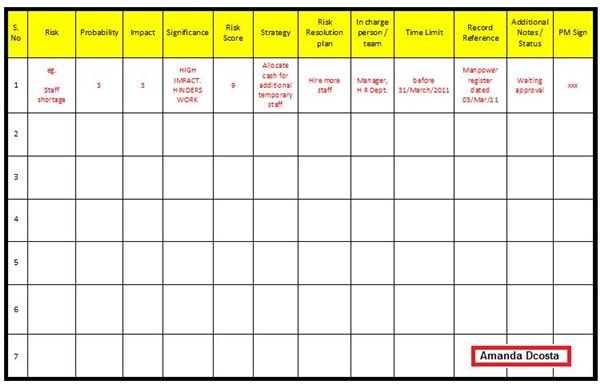Free Risk Register Templates: Free Download for Project Risk Register & Tips How to Use
Risk Register Template for Project Managers
The basic idea behind the use of risk register templates is to get a glimpse into the actual working of risk management for a particular risk or a set of risks. A business project is continually threatened with risks, and irrespective of the severity or frequency of it, risks have to be documented. Hence, from a record point of view, risk register templates fulfill the role of risk documentation.
Here is a free risk register template you can download for free, right here on Bright Hub. We will discuss other options below, followed by a walk through of how to use these templates effectively.
Download: Free Risk Register Template for Project Managers (MS Word)
Additional Risk Register Templates
Irrespective of the type of project or risk, or even the techniques of project management applications (Business, Engineering, Technical, etc.), risk registers show a basic template pattern. It gives a fairly clear picture of how a project risk is managed at a glance and is also ideal for making presentations at meetings. It is a compilation of data from various sources and registers.
There are some registers which highlight the type of risk assessment done in a project. For example, if more emphasis is put on Qualitative Analysis with a P-I Index, the report too reflects this qualitative rating. At Project Management Docs2, a free download is available with a Qualitative Analysis approach.
At Risk Management Plan Template3, a detailed approach to the documentation and registering of risks is adopted.
* Please find these free downloads for risk register templates at the end of the article.
Outline of a Risk Register Template
Most Risk Registers follow a basic pattern of documenting risks. The below highlighted features are a general description of important data that may be found in the most common risk register templates.
Risk name: This section highlights the name of the risk that is identified - in clear and concise terms. For example if it is a shortage of manpower, this entry for ‘risk name’ may be entered as ‘manpower shortage’. Keep it as easily understood as possible.
Probability: This entry is based on the P-I Matrix information obtained via the methods of risk assessment. It may be as per various grading from Low to Medium to High (indicated by 1, 2 or 3) on the Matrix.
Impact: This again is data obtained from the P-I Matrix similar to the probability grading.
Significance: This entry indicates how the risk will impact or affect the project if left unattended to.
Risk Score: Quantitative risk assessment gives an assessment in numerical terms. This value may be entered if it is such a value. One apt example is the Decision Making Tree. If data obtained is from the P-I Matrix, then the P-I Matrix rating for that particular risk may be entered. However state the method used and its respective value.
Strategy: This entry should ideally indicate the measure that has to be adopted in order to overcome or deal with that risk. For example, in the case of ‘manpower shortage’, the ideal strategy that has to be adopted would be to hire additional manpower.
Risk resolution plan: This is an indication of the decision made for risk resolution. It may be similar to the strategy entry; but in multiple options, it may show variances.
Personnel /team in charge: While risks are to be resolved, it is important to know who or which team will be responsible for the resolution of the risk. It denotes risk ownership and responsibility. In the stated example, the Human Resource Department headed by the HR Manager may be responsible.
Time frame: Risk resolution has to be done within a definite time frame and not as and when it pleases each stakeholder. Hence and entry of the time frame too is helpful in obtaining such information at a glance.
Record reference: Risk information is obtained from many registers and documents such as risk assessment reports that are part of the project’s documentation process. Indicate the record / register or document that corresponds with the mentioned risk.
Status: Is the risk resolution in process? Is it completed and resolved? Is it yet to initiate? Such details too should be entered in the Risk Register template.
Project Manager signature: Every entry that is made in the Risk Register has to be supersigned by the project manager. This indicates that the project manager is aware of each risk’s management irrespective of the team / department responsible.
Conclusion
Every project manager should create a risk register for a project. Free risk register templates are easily available for those who do not have the time or patience to break down the entire process in an organized manner. See our references section below for some top choices.
Credit and Reference
Image Credit: Amanda Dcosta
Resource: Liverpool John Moores University https://www.ljmu.ac.uk/infrastructure/RiskBusContinuityHandbook/70035.htm
Free Downloads
1 Free Risk Register Template for Project Managers: https://images.brighthub.com/media/4FE4CA_risk-register-template-for-project-managers.docx (MS Word)
2 Project Management Docs: https://www.projectmanagementdocs.com/templates/risk-register.html (MS Excel and Adobe PDF)
3 Risk Management Plan Template: https://www.carnegiequality.com/quality-assurance/risk-management-plan-template/ (MS Word and Open Office)
